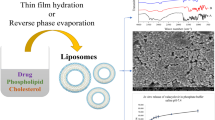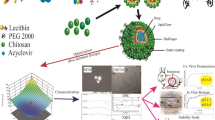Abstract
The aim of the present study was to design a depot delivery system of acyclovir sodium using multivesicular liposomes (MVLs) to overcome the limitations of conventional therapies and to investigate its in vivo effectiveness for sustained delivery. MVLs of acyclovir were prepared by the reverse phase evaporation method. The loading efficiency of the MVLs (45%–82%) was found to be 3 to 6 times higher than conventional multilamellar vesicles (MLVs). The in vitro release of acyclovir from MVL formulations was found to be in a sustained manner and only 70% of drug was released in 96 hours, whereas conventional MLVs released 80% of drug in 16 hours. Following intradermal administration to Wistar rats, the MVL formulations showed effective plasma concentration for 48 hours compared with MLVs and free drug solution (12–16 hours). Cmax values of MVL formulations were significantly less (8.6–11.4 μg/mL) than MLV and free drug solution (12.5 μg/mL). The AUC0–48 of the MVL formulations was 1.5- and 3-fold higher compared with conventional liposomes and free drug solution, respectively. Overall, formulations containing phosphatidyl glycerol as negatively charged lipid showed better results. The MVL delivery system as an intradermal depot offers the advantage of a very high loading and controlled release of acyclovir for an extended period of time. The increase in AUC and decrease in Cmax reflects that the MVL formulations could reduce the toxic complications and limitations of conventional IV and oral therapies.
Similar content being viewed by others
References
Miranda PD, Blum MR. Pharmacokinetics of acyclovir after intravenous and oral administration.Antimicrob Chemother. 1983;12:(Suppl. B):29–37.
Wagstaff AJ, Faulds D, Goa KL. Aciclovir. A reappraisal of its antiviral activity, pharmacokinetic properties and therapeutic efficacy.Drugs. 1994;47:153–205.
Bryson YJ, Dillon M, Lovett M, et al. Treatment of first episodes of genital herpes simplex virus infection with oral acyclovir. A randomized double-blind controlled trial in normal subjects.N Engl J Med. 1983;308:916–921.
Goldberg LH, Kaufman R, Kurtz TO, et al. Long-term suppression of recurrent genital herpes with acyclovir.Arch Dermatol. 1993;129:582–587.
Wade JC, Newton B, McLaren C, et al. Intravenous acyclovir to treat mucocutaneous herpes simplex virus infection after marrow transplantation: a double blind trial.Ann Intern Med. 1982;96:265–269.
Ran Y, Yalkowsky SH. Halothane, a novel solvent for the preparation of liposomes containing 2–4′-amino-3′-methylphenul benzothiazole (AMPB), an anticancer drug: a technical note.AAPS PharmSciTech. 2003;4:E20.
Mumper RJ, Hoffman AS. The stabilization and release of hirudin from liposomes or lipid-assemblies coated with hydrophobically modified dextran.AAPS PharmSciTech. 2000;1:E3.
Riaz M, Martin F, Weiner H. Liposomes as a drug delivery system.Drug Dev Ind Pharm. 1989;15:1523–1524.
Lasic DD, Papadjopoulos D. Liposomes revisited.Science. 1995;267:1275–1276.
Meyer J, Whitcomb L, Collins D. Efficient encapsulation of proteins within liposomes for slow releasein vivo.Biochim Biophys Res Commun. 1994;199:433–438.
Kim T, Murdane S, Gruber A, Kim S. Sustained-release morphine for epidural analgesia in rats.Anesthesiology. 1996;85:331–338.
Khatibi S, Howell SB, McCully C. Prolongation of action in CSF by encapsulation into multivesicular liposomes.Am Soc Clin Oncol. 1991;10:282–286.
Langston MV, Rampresad MP, Karali TT, Galluppi GR, Katre NV. Modulation of the sustained delivery of myelopoietin (Leridistim) encapsulated in multivesicular liposomes (DepoFoam).J Control Release. 2003;89:87–99.
Kim S, Turker MS, Chi EY, Sela S, Martin GM. Preparation of multivesicular liposomes.Biochim Biophys Acta. 1983;728:339–348.
Spector MS, Zasadzinshi JA, Sankaram MB. Technology of multivesicular liposomes, a model biliquid.Foam Langmuir. 1996;12:4704–4708.
Katre NV, Asherman J, Schaefer H, Hora M. Multivesicular liposome (Depo Foam) technology for the sustained delivery of insulin like growth factor-I (IGF I).J Pharm Sci. 1998;87:1341–1345.
Kim S. Depofoam mediated drug delivery into cerebrospinal fluid.Methods Neuroscience. 1994;21:118–131.
Kim T, Kim J, Kim S. Extended release formulation of morphine for subcutaneous administration.Cancer Chemother Pharmacol. 1993;33:187–190.
Kim S, Howell S, inventors. Multivesicular liposomes having a biologically active substance encapsulated therein in the presence of a hydrochloride. US Patent 5 807 572. September 15, 1998.
**ao CJ, Qi XR, Aini W, Wei SL. Preparation of cisplatin multivesicular liposomes and release of cisplatin from the liposomes in vitro.Yao Xue Xue Bao. 2003;38:133–137.
Chamberlain MC, Khatibi S, Kim JC, Howell SB, Chatelut E, Kim J. Treatment of leptomeningital metastasis with intraventricular administration of Depot cytarabine (DTC 101).Arch Neuro. 1993;50:261–264.
Katare NV, Asherman J, Schaeger H, Hora M. A multivesicular lipid based sustained release system for the delivery of therapeutic proteins. Proc. 8th Int. Pharm. Technol. Symp. Turkey 1996;20–21.
Freeman DJ, Sheth NV, Spruance SL. Failure of topical acyclovir ointment to penetrate human skin.J Antimicrob Agents Chemother. 1986;29:730–732.
Han HK, Amidon GL. Targeted prodrug design to optimize drug delivery.AAPS PharmSci. 2000;2:E6.
Bundgaard H, Jensen E, Falch E. Water-soluble, solution-stable, and biolabile N-substituted (aminomethyl) benzoate ester prodrugs of acyclovir.Pharm Res. 1991;8:1087–1093.
Shao Z, Park G, Krishnamoorthy R, Mitra AK. The physicochemical properties, plasma enzymatic hydrolysis, and nasal absorption of acyclovir and its 2′-ester prodrugs.Pharm Res. 1994;11:237–242.
Chikhale PJ, Venkatraghavan V, Bodor NS. Improved delivery through biological membranes LX: Intradermal targeting of acyclovir using redox-based chemical drug delivery systems.Drug Del. 1996;3:17–26.
Krenitsky TA, Hall WW, de Miranda PD, Beauchamp LM Schaeffer HJ, Whiteman PD. o-Deoxyacyclovir: a xanthine oxidase-activated prodrug of acyclovir.Proc Natl Acad Sci USA. 1984;81:3209–3213.
Shojaei AH, Zhou S, **aoling L. Transbuccal delivery of acyclovir (II): Feasibility, system design, andin vitro permeation studies.J Pharm Pharmceut Sci. 1998;1:66–73.
Law SL, Huang KJ, Chiang CH. Acyclovir-containing liposomes for potential ocular delivery. Corneal penetration and absorption.J Control Release. 2000;63:135–140.
Seth AK, Mishra A. Mathematical modelling of preparation of acyclovir liposomes: reverse phase evaporation method.J Pharm Sci. 2002;5:285–291.
Boulieu R, Gallant C, Silberstein N. Determination of acyclovir in human plasma by high-performance liquid chromatography.J Chromat. 1997;B693:233–236.
Author information
Authors and Affiliations
Corresponding author
Additional information
Published: September 20, 2005
Rights and permissions
About this article
Cite this article
Jain, S.K., Jain, R.K., Chourasia, M.K. et al. Design and development of multivesicular liposomal depot delivery system for controlled systemic delivery of acyclovir sodium. AAPS PharmSciTech 6, 8 (2005). https://doi.org/10.1208/pt060108
Received:
Accepted:
DOI: https://doi.org/10.1208/pt060108




